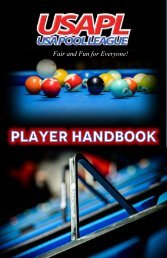Create successful ePaper yourself
Turn your PDF publications into a flip-book with our unique Google optimized e-Paper software.
Coaching Timeouts<br />
Coaching is encouraged but must be done in accordance with the following<br />
timeout regulations.<br />
<br />
Each team may use a maximum of one timeout per game and three<br />
timeouts per set. There is also a maximum number of timeouts that may<br />
be used per team match which differs based on team size (see below).<br />
Timeouts 5-players 4-players 3-players<br />
Per Game 1 1 1<br />
Per Set 3 3 3<br />
Per Team Match 10 9 8<br />
<br />
<br />
<br />
<br />
<br />
<br />
<br />
<br />
<br />
A timeout may be called by the shooter or anyone on the shooter’s<br />
team, and must be acknowledged by the opposing player (not the<br />
opposing player’s teammates).<br />
If a timeout is called and the shooting team has no timeouts remaining,<br />
any member of the opposing team may issue a warning. If the warning<br />
is issued, no timeout may be taken and there is no further penalty. If no<br />
warning is given before the opposing player acknowledges the timeout,<br />
the timeout is granted. The opposing player may check with his or her<br />
team to verify the availability of timeouts.<br />
Once a timeout is called and acknowledged, it must be taken at that<br />
time. If not taken when called and acknowledged, it is still charged.<br />
Timeouts are limited to 90 seconds.<br />
Any player on a team’s roster may be a coach, regardless of whether<br />
they are playing in the match. However, a coach cannot simultaneously<br />
play a match on one table and coach on another.<br />
Once a timeout is called and the coach is named, only that coach may<br />
confer with the shooter. No other player may offer an opinion or advice<br />
to the shooter or the coach.<br />
The shooter will designate the coach on each instance and may change<br />
coaches throughout the set.<br />
The coach is allowed to point at or touch the table while offering advice<br />
but may not touch any ball or mark the table in any way. The coach<br />
must leave the table before the shot and cannot stand in the shooter’s<br />
line of sight.<br />
The coach may inform his or her teammate of a prior foul committed<br />
by the opponent and the teammate may then call the foul.<br />
26





